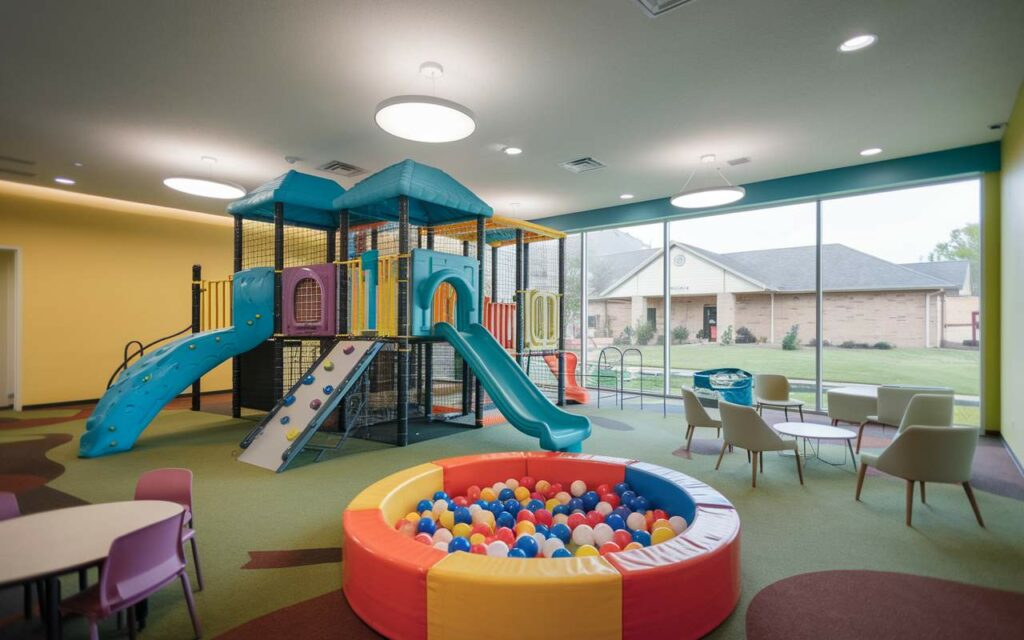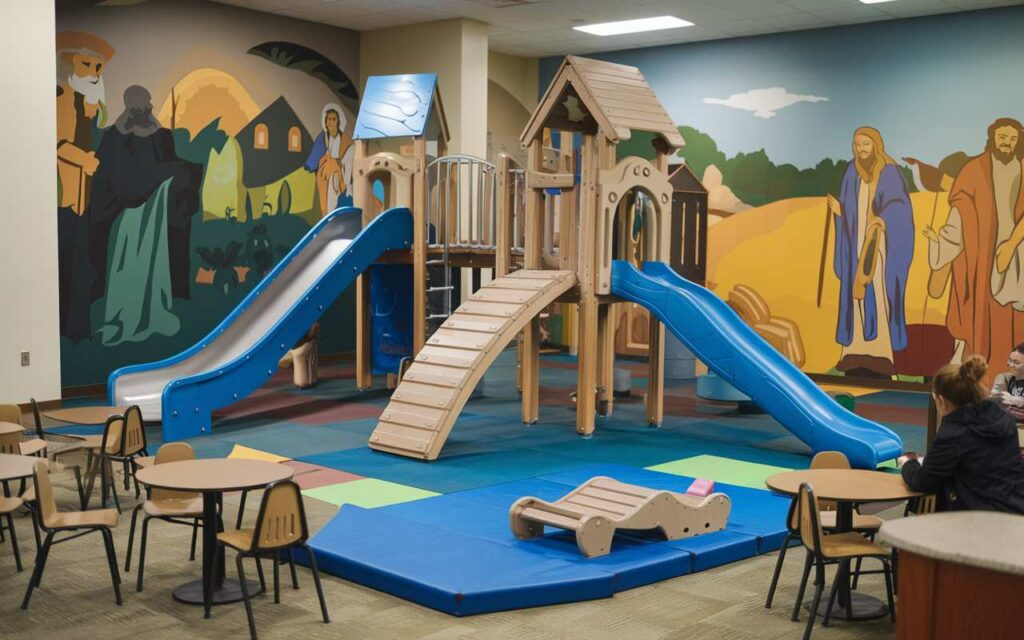Have you ever watched kids at playground and wondered about the magic behind their laughter? Deciding between indoor play vs outdoor play can feel like a puzzle. Both options bring unique joys and benefits to a child’s world. Understanding these differences can help you make the best choice for your little one’s needs and happiness. Whether it’s the creative adventures inside or the energetic escapades outside, knowing how to balance both will ensure a well-rounded and delightful playtime experience.
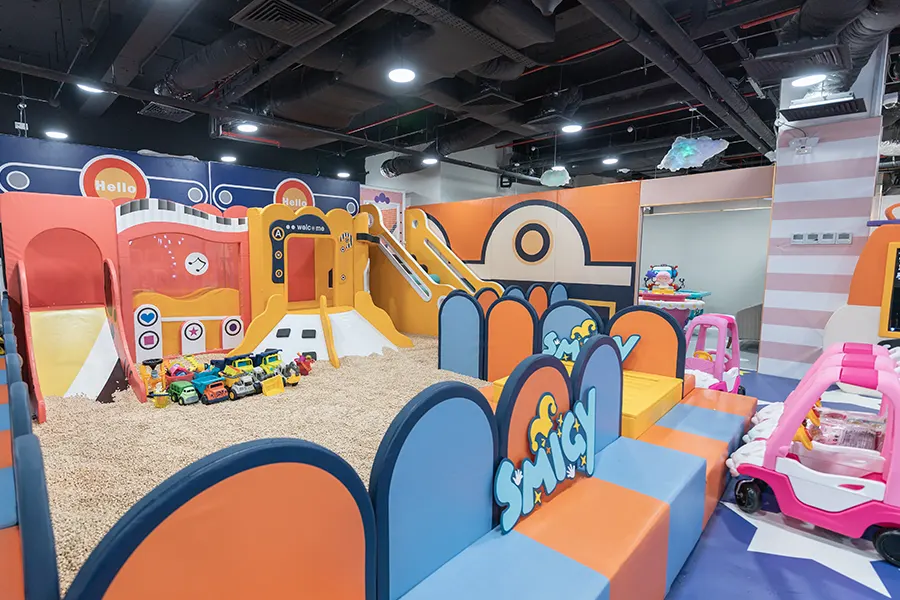
What Is Indoor Play?
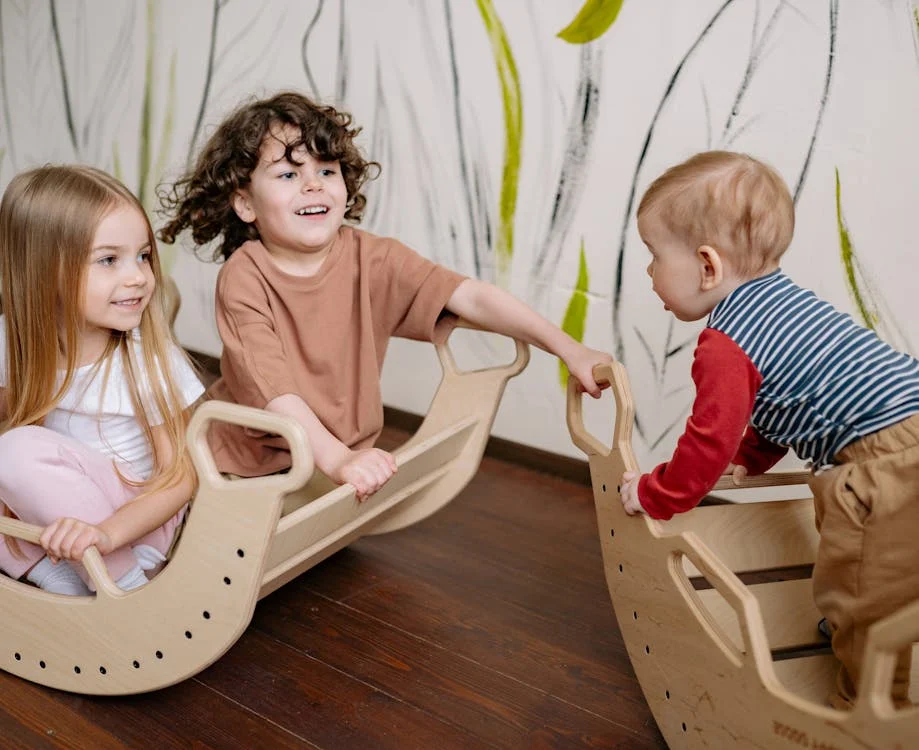
Indoor play, also known as indoor playground or soft play, involves activities within enclosed spaces, allowing children to engage in various forms of play in a controlled environment. These activities can range from simple games and puzzles to complex interactive installations, providing a safe and stimulating environment regardless of weather conditions.
The concept of indoor play dates back to the 19th century when early childhood education pioneers like Friedrich Fröbel and Maria Montessori emphasized the importance of play in learning. The first indoor playgrounds appeared in the early 20th century, with facilities like McDonald’s PlayPlaces and Chuck E. Cheese’s popularizing the idea in the 1970s and 1980s. Over the years, indoor play spaces have evolved to include sophisticated play structures, interactive exhibits, and technology-driven activities.
If you want to learn more about What Is Indoor Play, click to read more.
What Are the Benefits of Indoor Play?
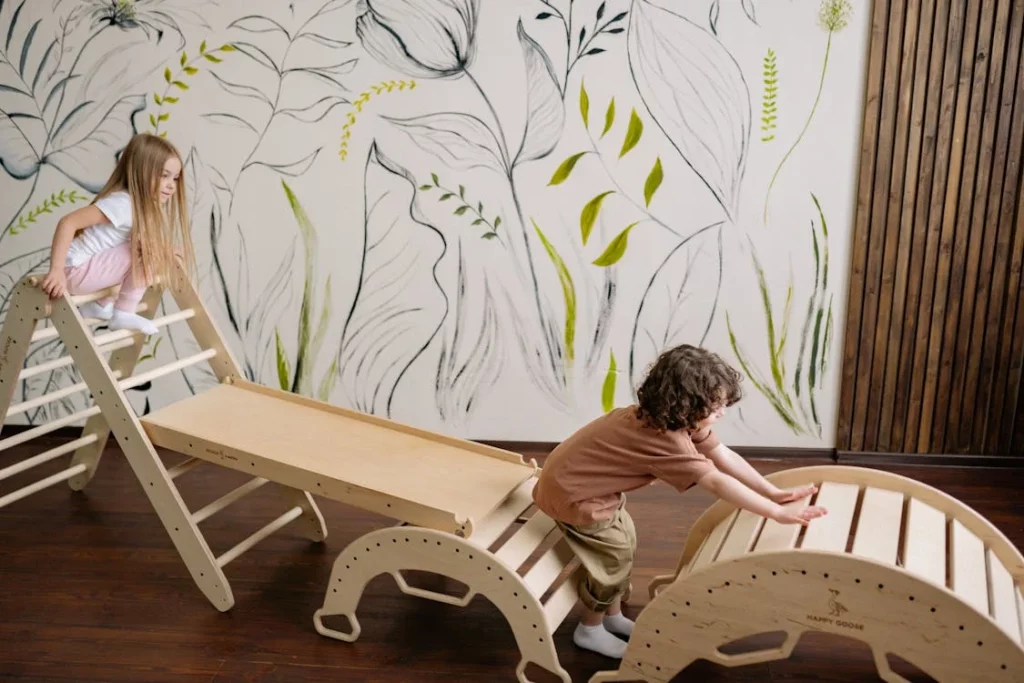
Indoor play offers numerous benefits that contribute to the overall development and well-being of children. These advantages include:
- Safety: Indoor play environments are designed to be safe and controlled, minimizing risks associated with weather, traffic, and other outdoor hazards. This ensures that children can play without constant supervision and worry.
- Year-Round Accessibility: Indoor play spaces are not affected by weather conditions, allowing for consistent play opportunities throughout the year. This is particularly beneficial in regions with extreme weather or limited outdoor spaces.
- Stimulates Creativity and Imagination: Indoor play often includes activities and equipment that encourage imaginative and creative play. From building blocks to role-playing areas, these environments foster cognitive development and problem-solving skills.
- Social Interaction: Indoor play spaces provide a venue for children to interact with peers, developing social skills such as sharing, cooperation, and communication. These interactions are crucial for emotional and social development.
- Physical Activity: Despite being indoors, many play centers include physical activities such as climbing, jumping, and running. These activities help develop gross motor skills and promote physical health.
- Educational Opportunities: Many indoor play areas incorporate educational elements, such as interactive exhibits, puzzles, and educational games. These features enhance learning in a fun and engaging way.
- Inclusivity and Accessibility: Indoor play environments can be designed to be inclusive and accessible for children with different abilities, ensuring that all children have the opportunity to play and learn in a supportive setting.
- Parental Convenience: Indoor play centers often provide amenities such as seating areas, Wi-Fi, and cafes, making them convenient for parents and caregivers. This allows for a more relaxed and enjoyable experience for the whole family.
For further exploration, you can browse our exclusive guide about Benefit of Inoodr Play.
What Is Indoor Play Activities?

Indoor play activities encompass a wide array of engaging and developmentally appropriate options for children. These activities are designed to stimulate creativity, enhance physical skills, and foster social interaction within a safe and controlled environment. Some common indoor play activities include:
- Creative Play: Drawing, painting, crafting, and building with blocks or LEGO
- Imaginative Play: Role-playing games, dress-up, pretend play, play kitchens, dollhouses, and puppet theaters
- Interactive Exhibits: Children’s museums, science centers, hands-on experiments, educational games, and sensory exploration areas.
- Physical Activities: Climbing walls, obstacle courses, trampolines, and soft play areas
- Digital Play: Educational apps, video games, and interactive learning tools
- Puzzles and Games: Board games, card games, and puzzles
- Music and Dance: Singing, dancing, and playing musical instruments
- Sensory Play: Sensory bins, sand tables, and water play stations
- Reading and Storytelling: Book reading, storytelling, and story-listening activities
What Is the Need for an Indoor Playground?
When it comes to keeping children entertained and engaged indoors, the options are as diverse as their imaginations. Whether you’re looking to entertain a bustling toddler, stimulate a curious preschooler, or offer a fun experience for older kids, indoor play environments can cater to all ages with the right activities and equipment. Here are the specific indoor playground equipment for each age group.
Indoor Play for Kids
- Interactive play structures
- Trampolines
- Climbing walls
- Ball pits
- Arcade games
- Educational exhibits
- Arts and crafts stations
Indoor Play for Toddlers
- Soft play areas
- Sensory bins
- Mini slides
- Safe climbing structures
- Ball pits
- Interactive floor games
- Simple puzzles and toys
Indoor Play for Preschoolers
- Climbing structures with age-appropriate challenges
- Role-playing and pretend play areas
- Craft and art stations
- Interactive learning games
- Small obstacle courses
- Reading and storytelling corners
- Musical play areas
What Is Outdoor Play?
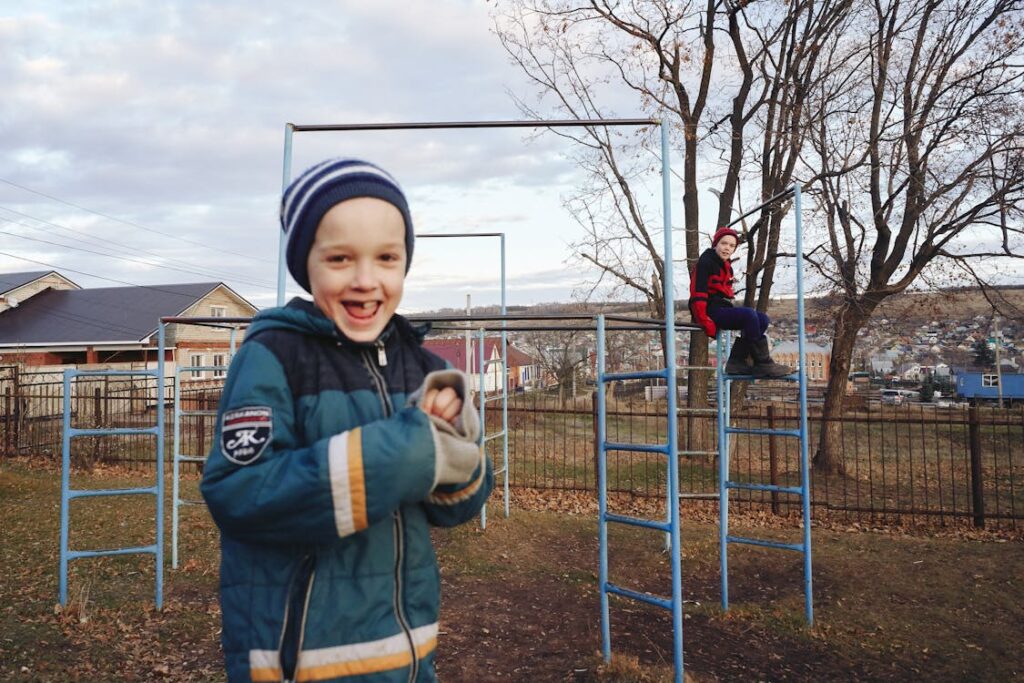
Outdoor play involves activities that occur in open-air environments, allowing children to engage with natural elements and participate in physical exercise. This type of play includes games, sports, and exploration that utilize outdoor spaces such as parks, playgrounds, and natural landscapes.
The concept of outdoor play has ancient roots, with early humans engaging in physical activities and games in natural settings. In the 19th century, outdoor play became more formalized with the rise of playgrounds and organized sports. The late 19th and early 20th centuries saw the development of public playgrounds designed to provide structured recreational spaces for children. The emphasis on outdoor play continued to grow throughout the 20th century, with a focus on the benefits of physical activity and interaction with nature. Today, outdoor play is recognized as essential for child development, promoting physical health, social skills, and a connection to the environment.
What Are the Benefits of Outdoor Play?
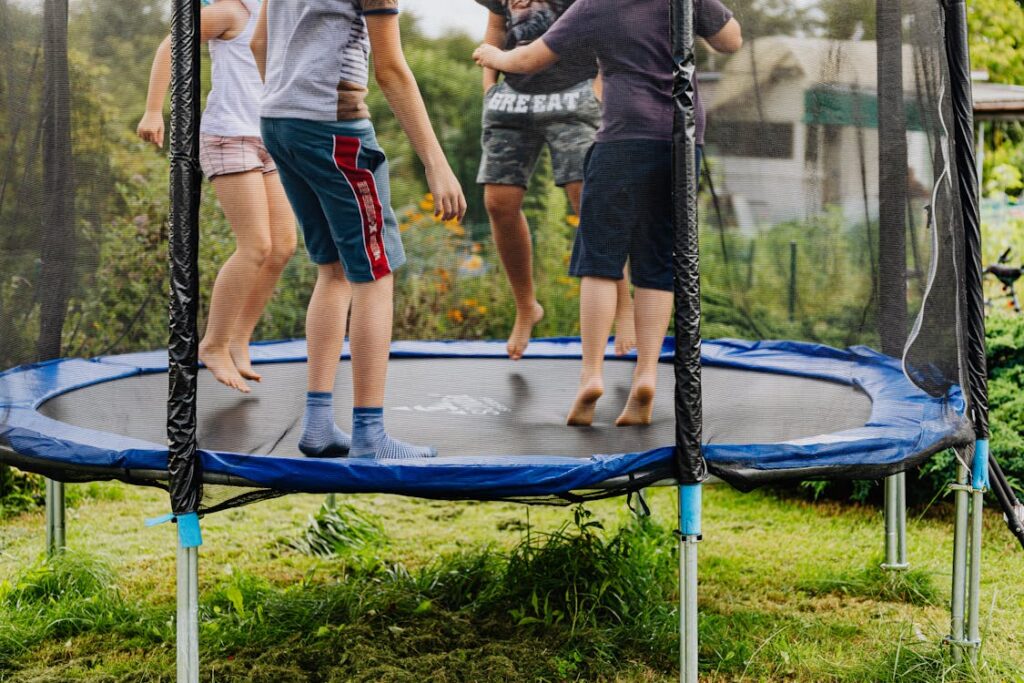
Outdoor play offers a world of benefits, from boosting physical health to fostering creativity. Let’s explore why it’s so vital.
- Physical Health: Outdoor play promotes cardiovascular fitness, muscle development, and coordination. Activities like running, climbing, and playing sports help build strength and endurance.
- Mental Well-being: Exposure to nature and physical activity reduces stress, anxiety, and depression. Outdoor play boosts mood and overall mental health by providing a refreshing break from indoor environments.
- Social Skills: Interacting with peers in outdoor settings enhances social skills such as teamwork, communication, and conflict resolution. Group games and activities foster cooperation and friendship.
- Cognitive Development: Exploration and problem-solving in natural environments stimulate cognitive growth. Outdoor play encourages creativity, critical thinking, and decision-making skills.
- Vitamin D Production: Sunlight exposure during outdoor play helps the body produce vitamin D, which is crucial for bone health and immune function.
- Connection to Nature: Regular outdoor play fosters a connection to the natural world, encouraging environmental awareness and appreciation. This connection can lead to a lifelong commitment to environmental stewardship.
- Imagination and Creativity: Outdoor environments provide diverse stimuli that inspire imaginative play and creativity. Natural settings and open spaces allow children to invent their own games and scenarios.
- Development of Motor Skills: Activities such as climbing, jumping, and balancing help develop fine and gross motor skills. Outdoor play provides varied surfaces and challenges that enhance physical coordination and balance.
What Is Outdoor Play Activities?
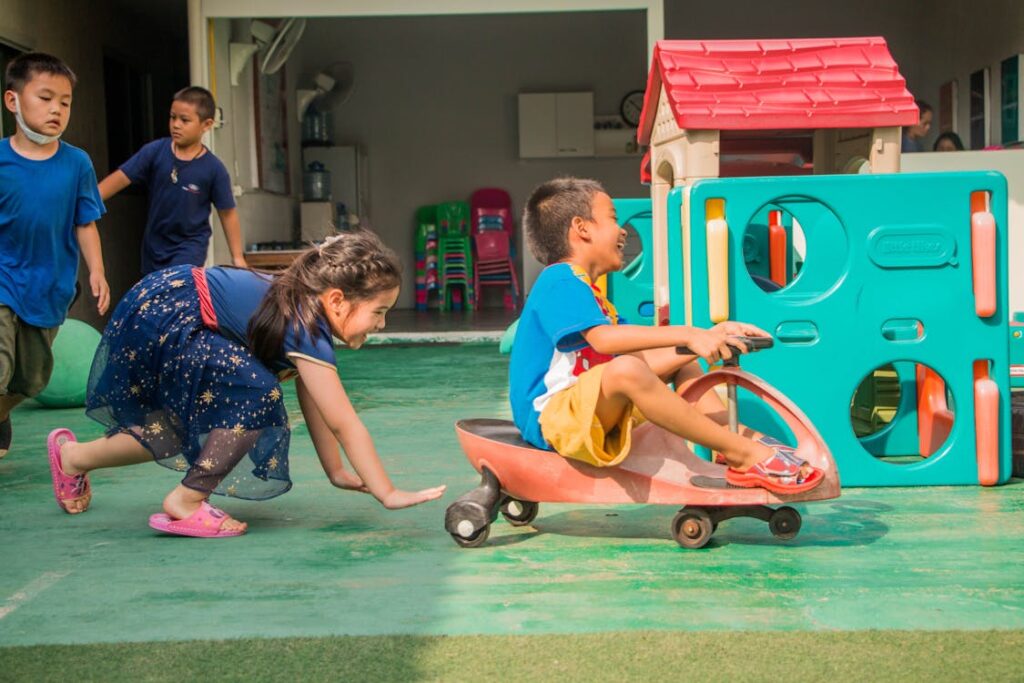
Outdoor play activities involve engaging in various forms of play that take place in natural or open-air environments. These activities can range from structured games to spontaneous exploration and adventure. Common outdoor play activities include:
- Sports: Soccer, basketball, baseball, and other organized games.
- Climbing and Swinging: Climbing frames and swings.
- Exploration: Hiking, nature walks, and scavenger hunts.
- Creative Play: Building forts, digging in sandboxes, and creating art with natural materials.
- Social Games: Tag, hide-and-seek, and group games that involve multiple participants.
- Water Play: Playing with sprinklers, fountains, or water tables.
- Bike Riding: Riding bicycles, scooters, or skateboards.
- Gardening: Planting and caring for a garden or outdoor plants.
What Is the Need for an Outdoor Playground?
Outdoor playgrounds cater to all ages, providing tailored equipment for early childhood, teenagers, and adults to stay active and engaged.
Outdoor Play for Early Childhood
- Slides
- Swing sets
- Sandbox
- Low climbing structures
- Interactive water features
- Age-appropriate playhouses
Outdoor Play for Teenage
- Skate parks
- Basketball courts
- Climbing walls
- BMX tracks
- Adventure courses
- Outdoor fitness equipment
Outdoor Play for Adulthood
- Outdoor gyms
- Walking and jogging trails
- Sports fields
- Picnic areas
- Garden spaces
- Outdoor fitness stations
What Is the Difference Between Indoor and Outdoor Play?
Ever wondered how indoor play differs from outdoor play? Let’s break down the key differences to help you choose the best environment for your indoor playground business and child’s growth and fun.
| Aspect | Indoor Play | Outdoor Play |
| Environment | Enclosed, controlled spaces | Open-air, natural settings |
| Weather Dependence | Not affected by weather | Affected by weather conditions |
| Safety | Typically safer, with padded equipment | Varied safety levels depending on equipment and environment |
| Physical Activity | Limited space for movement; focuses on fine motor skills | Promotes extensive physical exercise; includes gross motor skills |
| Social Interaction | Often structured, with controlled group sizes | Typically less structured; encourages larger group interactions |
| Creativity & Imagination | Facilitated through toys and themed play areas | Enhanced by natural elements and open spaces |
| Developmental Focus | Cognitive and fine motor skills, imaginative play | Gross motor skills, social skills, and exploration |
| Equipment | Soft play structures, educational toys, interactive exhibits | Climbing structures, sports equipment, natural play elements |
| Accessibility | Suitable for all weather and time of day | Limited by weather conditions and daylight |
| Parental Supervision | Easier to supervise in a controlled environment | Requires more vigilant supervision due to larger play areas and environmental variables |
| Health Benefits | Safe, dry, controlled exercise | Exposure to fresh air, vitamin D from sunlight, and varied physical activity |
| Educational Chances | Often includes educational toys and interactive learning | Learning through nature and physical challenges |
Outdoor Play Is Better than Indoor Play?
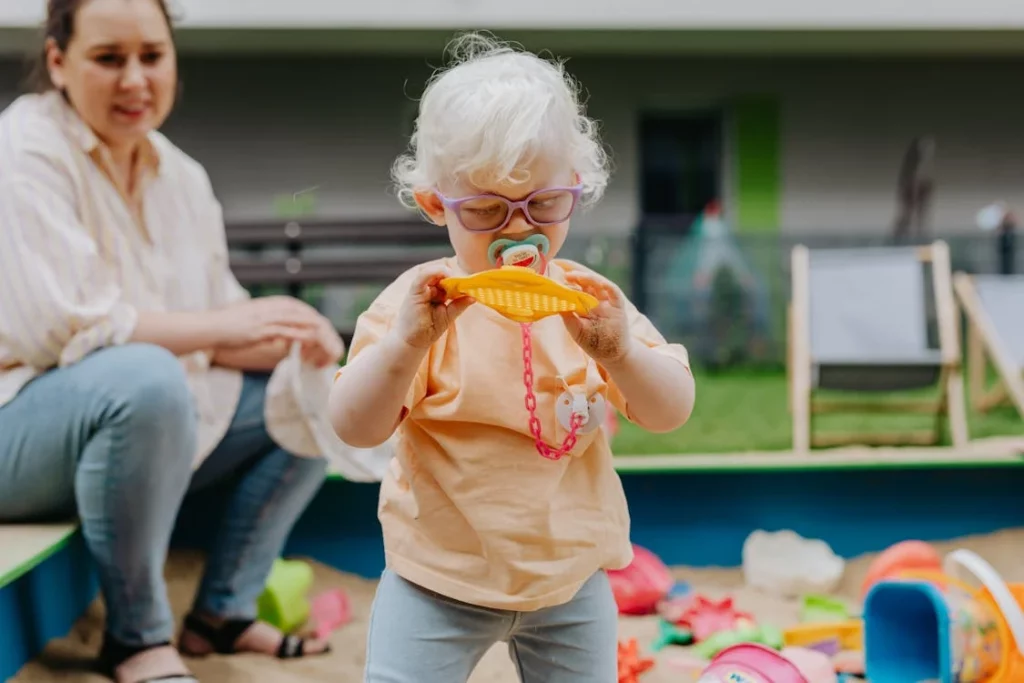
To some extent, the answer is yes, with qualifications.
- Physical Health Benefits: Studies show that children who engage in outdoor play are more likely to meet recommended physical activity levels. For example, a study published in the Journal of Physical Activity and Health found that children who play outside are more active and have better overall fitness compared to those who play primarily indoors.
- Mental Health and Well-being: Outdoor play has been linked to reduced stress and improved mood. Research from the American Academy of Pediatrics highlights that children who spend time in nature exhibit lower levels of anxiety and depression. A study from the Journal of Environmental Psychology also suggests that exposure to natural settings can significantly boost mood and cognitive function.
- Vitamin D Production: Outdoor play increases sunlight exposure, which is crucial for vitamin D synthesis. According to the National Institutes of Health (NIH), adequate vitamin D is essential for bone health and immune function, and outdoor play helps children achieve the necessary levels more effectively than indoor activities.
- Social Skills Development: Outdoor play often involves larger, less structured group activities that can enhance social skills. A study in the Journal of School Health found that children who participate in outdoor group games develop stronger social skills and better teamwork abilities compared to those who play in controlled indoor settings.
While outdoor play offers these significant benefits, it is also essential to recognize that indoor play provides valuable advantages, such as a controlled environment and protection from harsh weather. Balancing both indoor and outdoor activities can offer a comprehensive approach to child development.
Indoor Play vs Outdoor Play: How to Choose?
The selection between indoor and outdoor play depends on several factors that relate to your child’s needs, the environment, and specific goals for their development. Here’s a guide to help you decide:
1. Consider the Weather
- Indoor Play: Ideal for inclement weather or extreme temperatures. It provides a consistent play environment regardless of outside conditions.
- Outdoor Play: Best enjoyed during favorable weather conditions. It allows children to benefit from fresh air and natural light but may be less accessible during rain, snow, or extreme heat.
2. Evaluate Space and Safety
- Indoor Play: Offers a controlled and safe environment with features like padded floors and child-proofed equipment. Suitable for limited or urban spaces where outdoor access might be restricted.
- Outdoor Play: Encourages larger physical activities and exploration but requires careful supervision and safety considerations. Outdoor spaces should be free of hazards and well-maintained.
3. Focus on Developmental Goals
- Indoor Play: Provides opportunities for fine motor skills development, imaginative play, and cognitive challenges through educational toys and interactive exhibits. It is beneficial for structured activities and skill-building in a controlled setting.
- Outdoor Play: Promotes gross motor skills, physical fitness, and social interactions through activities like climbing, running, and group games. It supports physical health, resilience, and connection with nature.
4. Assess Social Interaction Needs
- Indoor Play: Often involves smaller, more controlled groups, which can be ideal for focused activities or one-on-one interactions. It allows for structured playdates or supervised group activities.
- Outdoor Play: Facilitates larger group interactions and social skills development. It provides a setting for children to engage with a broader range of peers and practice cooperation and teamwork.
5. Look at Accessibility and Convenience
- Indoor Play: Accessible year-round, regardless of weather. It’s convenient for busy families or those with limited access to outdoor spaces.
- Outdoor Play: Offers a dynamic and stimulating environment but may require travel to parks or playgrounds. It’s more suitable for families with easy access to outdoor spaces and good weather conditions.
6. Consider Health Benefits
- Indoor Play: Protects from environmental pollutants and allergens, providing a clean and controlled environment.
- Outdoor Play: Enhances exposure to natural elements, promotes vitamin D production, and can contribute to overall well-being by allowing children to experience fresh air and diverse sensory inputs.
Conclusion
In the grand debate of indoor play vs outdoor play, there’s no clear winner because both hold immense value for a child’s development. Indoor play nurtures creativity and safety, while outdoor play fosters physical health and exploration. By combining the best of both worlds, you can provide a rich and varied play environment that supports every aspect of your child’s growth. Embrace the balance, and watch your child flourish in all the wonderful ways play can offer.
FAQ
Q1: What Age Group Is the Indoor Playground Suitable For?
Indoor playgrounds are designed to cater to various age groups, typically ranging from toddlers to older children. Specific areas within these playgrounds often target:
- Toddlers (1-3 years old): Soft play zones with padded equipment and sensory activities.
- Preschoolers (3-5 years old): Interactive play structures, educational toys, and imaginative play areas.
- Older Children (6-12 years old): More complex play structures, climbing walls, and interactive digital games.
Q2: What Age Group Is the Outdoor Playground Suitable For?
Outdoor playgrounds are typically designed to accommodate a wide range of age groups, providing equipment and play areas that are suitable for:
- Toddlers (1-3 years old): Low climbing structures, baby swings, and sandboxes.
- Preschoolers (3-5 years old): Slides, small climbing walls, and interactive play equipment.
- Older Children (6-12 years old): Larger climbing structures, monkey bars, sports fields, and adventure play zones.

